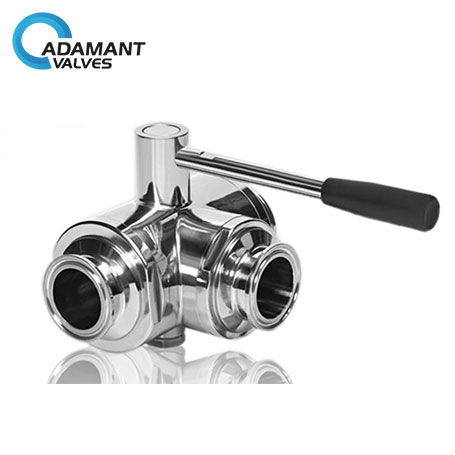Ball valves are mainly used in piping to cut off, distribute and change the flow direction of media. The ball valve is a new type of valve widely used.
Working principle
The working principle of the ball valve is to turn the spool to make the valve unblocked or blocked. Ball valve switch is light, small, can be made into a large caliber, reliable seal, simple structure, easy maintenance, sealing surface and sphere are often in the closed state, not easy to be eroded by media, widely used in various industries.
Ball valve and cock valve belong to the same type of valve, only its closing part is a sphere, the sphere revolves around the center line of the valve body to open and close a valve.
Classification
Sanitary ball valves can be divided into straight-through type, three-way type, and right-angle type according to their channel position. Three-way ball valves have T-type and L-type. T-type can make three orthogonal pipelines interconnect and cut off the third passage, and play the role of diversion and confluence. L-shape can only connect two orthogonal pipelines, but can not keep the third pipeline interconnected at the same time. It only plays the role of distribution.
1. The three way ball valve adopts an integrated structure. The sealing type of four-side seat has fewer flange connections and high reliability. The design realizes lightweight.
2. The three-way ball core is divided into T-type and L-type, with long service life, large circulation capacity, and small resistance.
3. Ball valves are divided into two types: single-acting and double-acting according to the acting mode. The single-acting mode is characterized by that once the power source fails, the ball valve will be in the state required by the control system.

Characteristic
According to different process equipment, pneumatic or electric valves can be selected to form pneumatic ball valves and electric ball valves, in which pneumatic ball valves must be equipped with valve positioners if they want to achieve proportional regulation, and electric ball valves should be equipped with electronic electric actuators or servo amplifiers if they want to achieve proportional regulation.
From the material, it can be divided into carbon steel ball valve, stainless steel 304 ball valve, 316 ball valve, and copper ball valve.
Usage method
1) Make sure that the pipeline and valves have been flushed before operation.
2) The operation of the valve is driven by the input signal size of the actuator to complete the rotation of the valve stem: when the positive rotation is 1/4 turn (900), the valve is closed. When the reverse rotation is 1/4 turn (900), the valve opens.
3) When the direction of the actuator indicates that the arrow is parallel to the pipeline, the valve is open; when the direction of the arrow is perpendicular to the pipeline, the valve is closed.
Purchase and Maintenance
Stainless steel ball valves are very easy to contact with other metal and iron products in the process of production and manufacture. In order to keep stainless steel valves from rusting, the simplest way is to follow the following process.
Firstly, after pickling of the finished product, the blank must be washed clean. If there are sand holes or perforations, the gas shielded arc welding should be used. Then grind and melt.
Second: finished products, after the completion of processing pressure test. It should be washed with water added with rust-proof powder.
Third: In the transport process, as far as possible use wooden box packaging, do not touch metal products.
Fourth: After installing the pipeline, it should be regularly maintained and maintained, for example, the valve stem is often coated with lubricant. Open and close the valve properly several times. The inner ball, valve stem and sealing surface are not easy to assimilate.
For more information, please visit http://www.adamantvalves.com/



Recent Comments